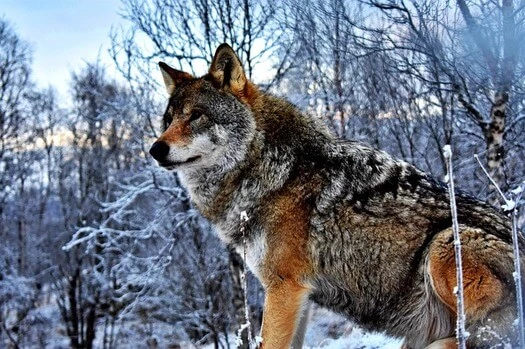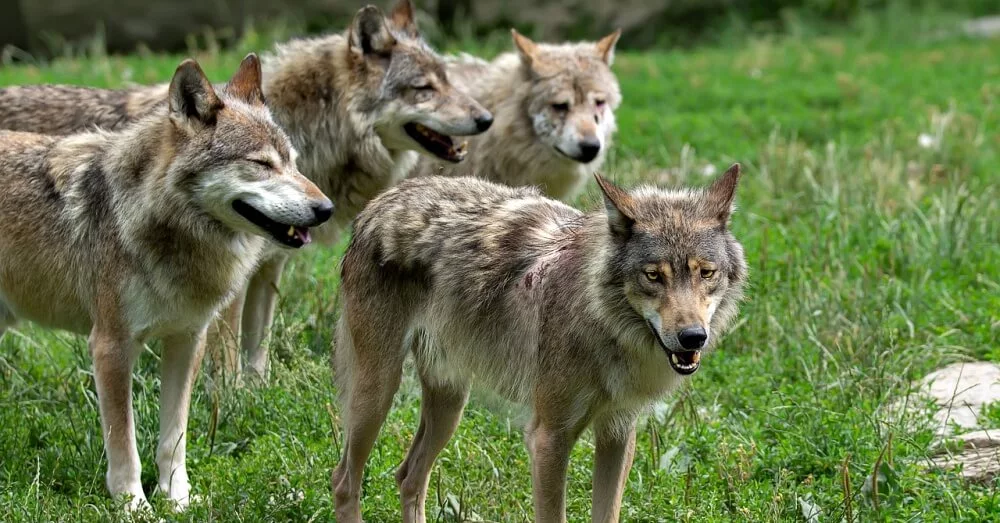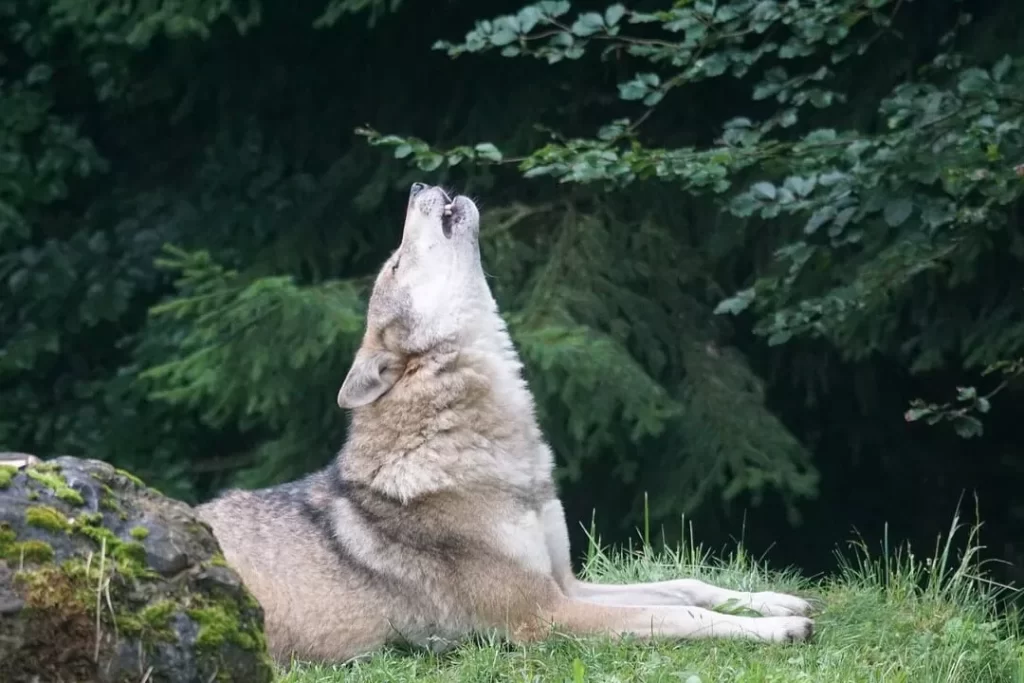The gray wolf (Canis lupus) also known as the grey wolf, belongs to the Canidae family. It is the large canine predator, native to North America and Eurasia.
They are well known among wolves as the ‘’common wolves’’ and ‘’timberwolves’’ and are popular among the wild canid family as the largest members.
Gray wolves are well known as a noble and a cunning predator. They have their fame as legendary due to their hunting valor, which evokes their fear, awe, and wonder.
Gray wolf is well recognized for its excellent hunting ability, pack behavior, and fierce appearance. The wolf has a major role in fairy tales and many mythologies.
Wolves have a unique body shape of 3.5 to 5.5 long and weigh about 80 pounds.
The beauty of their fur makes them beautiful among other animals. The most common shade of the wolf’s fur is tawny brown but that can range from the pure white to black color.
The body of the wolves has the ability to thrive in harsh environments i.e tundra to woods, grasslands, forests, and deserts.
Gray wolves are the social animals containing a dominant or Alpha male or female and other members and offsprings of that pack are not related to that dominant pair.
Wolves remain and travel in the form of packs in which each member has its own role and hierarchy in the pack. The packs mostly consist of up to 12 members.
The distinct sound of the wolves “the howl” that can travel to several miles, makes them unique.
They howl for many reasons i.e to gather the pack’s members, to attract mates, communicating with other packs or to warn off the members when some intruders attack.
Habitat History
Gray wolves originated from Eurasia more than 750,000 years ago and made their way to North America. The habitat of gray wolves grew to cover the Northern Hemisphere and ultimately came to occupy the tag of the largest range of mammals in the history, save the lions.

These quickly adapting mammals thrived in a wide range of climates i.e harsh heat of deserts of Arabia to the coldest weather of the arctic regions of Greenland.
If it is widely estimated, it can be said that 2 million of the grey wolves inhabited the earth about 5000 years ago.
Habitat Today
Gray wolves can live in a diverse range of the habitats ranging from woodlands, grasslands, tundra, deserts to the mountains areas and forests. They require a stable population of prey in large areas for their food.
Every wolf packs have a varying range of for preying varies from 80-300 miles that number changes according to the population density of the prey animals in that area. This range can be upmost to 1000 miles in the extreme northern regions.
According to an estimate, more than 7000 wolves are living in Alaska. In the lower states of America i.e Montana, Wyoming, Michigan, Idaho, and Wisconsin, about 5000 gray wolves inhabit.
Grey wolves inhabit outside the United States in the regions of Italy, Poland, Russia, Scandinavia, Spain, and Portugal.
As the largest member among the canine family and the ancestor to the domestic dogs, the gray wolves occupy the home in the Asia, Greenland, Europe, and North America. Before the drastic decrease in the population of the grey wolves were the most widely ranged carnivores in the world.
Today there are many efforts are being done to conserve the remaining members of the gray wolves in their natural habitats.
Factors Affecting Their Habitat
Several factors can affect the habitat of gray wolves. These factors include climate change, habitat fragmentation, and human encroachment on their habitats. These factors can cause changes in their habitats, affecting their food sources, mating behaviors, and survival.
Dwindling Numbers
The gray wolf population is greatly decreasing by habitat destruction, prejudices, and hunting. The people of the eastern hemisphere held prejudices against the gray wolves since the Middle Ages and the animals destroying was underway.
The destroying of habitats and hunting made the gray wolves endangered in most countries of Europe. In the areas of North America, where the gray wolves were found common, the bounties were placed on the animals for their fur pelts.
During the mid-1930s, a large number of the gray wolf were killed in most areas of the United States. Michigan and Minnesota were homes to the gray wolves by the 1970s.
Population

Population threats
Population threats include the fragmentation and loss of habitat which leads to the considerable loss of the population. As they are considered as the livestock predators, the wolves are killed the whole packs and in individuals.
The species of the wolves are not legally protected so they are widely trapped and hunted.
Population number
The population of gray wolves is widely spread throughout the range of its habitats. The estimated stable population of wolves is 400,000 animals. The grey wolf is classified as the Least Concern (LC) on the IUCN Red List.
Ecological niche
By feeding the various animal species like deer, or elk, they sustain their population thus benefitting the other animals and plant species in their range. After hunting and eating the prey, the carcasses left by the wolves are a good source of food for the other animals like grizzly bears and scavengers.
Wolf Conservation
In the legislation of 1973, the United States made rules to save the gray wolves from further disappearing. In the same year, Congress passed the Endangered Species Act to protect the gray wolves.
Wildlife preservation groups introduced the gray wolves to central Idaho and Yellowstone Park in the 1990s. Now the gray wolf has been added to the list of endangered species in more than 40 states of the United States by the U.S Fish and Wildlife Service.
What do they eat
Gray wolves mostly hunt large animals like bison, sheep, elk, deer, mountain goats, and caribou. Wolves are carnivores so they prefer to eat the large hoofed animals.
They also hunt small mammals like rodents, hares, and beavers, and hunt them when it is available to them.
An adult wolf can eat 20 pounds of meat in a meal and can go longer for a week without any food. Some species of wolves can survive for 17 days without eating anything.
Wolves have 42 teeth including the large molars to crush and grind the bones of prey. The length of canines and fangs is about 2-1⁄2 “. The jaws of wolves are extremely powerful with the biting capacity of 1000 to 1500 pounds per square inch.
Mating Habits
Mating season of grey wolves is January to April in which the alpha male and female from each pack breeds. The male wolves are sexually mature at the age of 3 years while the female ones are mature at 2 years of age.
Alpha pair of the pack is monogamous and they mate for life until one of the members dies then a new alpha partner for the other one is chosen and the pair is established again.
The gestation period of wolves varies from 60-63 and female gives birth to 1-14 pups but the common numbers are 6-7. The female of the pair digs the cave or den for giving birth to the young ones and she gives birth in that cave and feeds. All the members of the packs feed the young ones for the first 45 days.
Mother of these young pups stays with them in the den for the first 3 weeks and then she leaves but the pups remain in the den until they reach the age of 8-10 weeks.
Wolves can live a life span of 8 to 13 years in the wild while in captivity, up to 15 years.
| MATING BEHAVIOR | Monogamy |
| PREGNANCY DURATION | 60-63 days |
| REPRODUCTION SEASON | January-April |
| INDEPENDENT AGE | 45 days |
| BABY NAME | Whelp , Pup |
Behaviour

All the wolves including gray wolves communicate by their body language, growling, scent making, howling, and barking. The major concern of communicating is strengthening the social regime of their pack.
Whenever a wolf wants to communicate with others that he is submissive to them, it will whimper, crouch and tuck his tail and if he wants to challenge the other wolf, he will growl and lay its ears back of his head.
A jaunty wolf will dance and bows. Howling is a sign for communicating to pull back the members of the pack together and to warn the strangers to move away while barking is a sign of warning.
As a matter of fact, the wolves do not howl at the moon however they howl in the lighter nights which usually happens during the full moon.
During the whole year, two phases undergo their lives, stationary phase takes place in the months of spring and summer when giving births to young ones. While the other phase is nomadic which lasts from autumn to winter.
Gray wolves prefer to move at nights and they can travel the distance up to 200 km per day.
Related: Top 10 Wolf Names with Meanings
Conclusion
Understanding the habitat of gray wolves is essential for their survival. Their habitat range covers most of North America, Europe, and Asia. The physical characteristics of their habitat, such as climate, vegetation, and water sources, impact their survival.
Den sites, resting sites, and hunting grounds are essential components of their habitat. Conservation efforts, such as protecting and restoring their habitats, are necessary to ensure their survival.
Human activities can significantly impact their habitat, making it important to manage human impacts to preserve their habitat. By preserving the habitat of gray wolves, we can help these majestic creatures thrive for generations to come.
